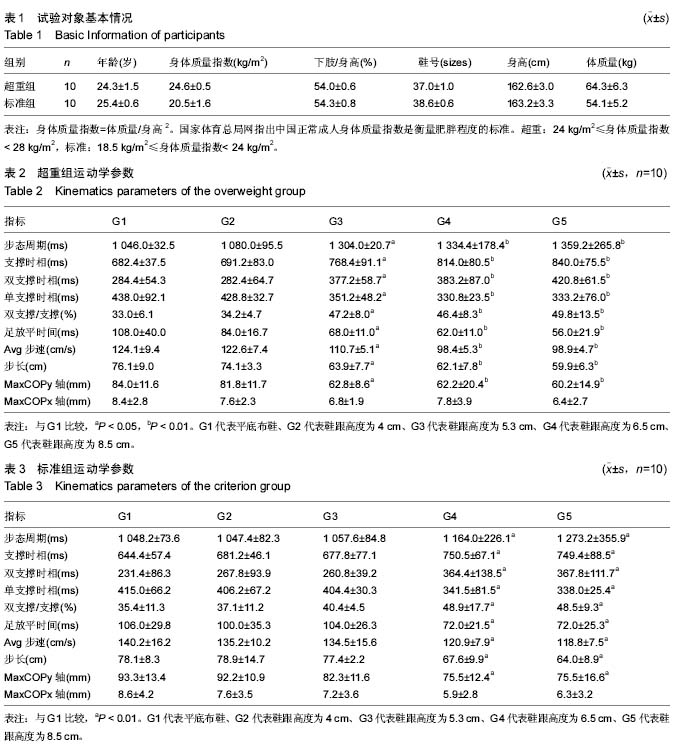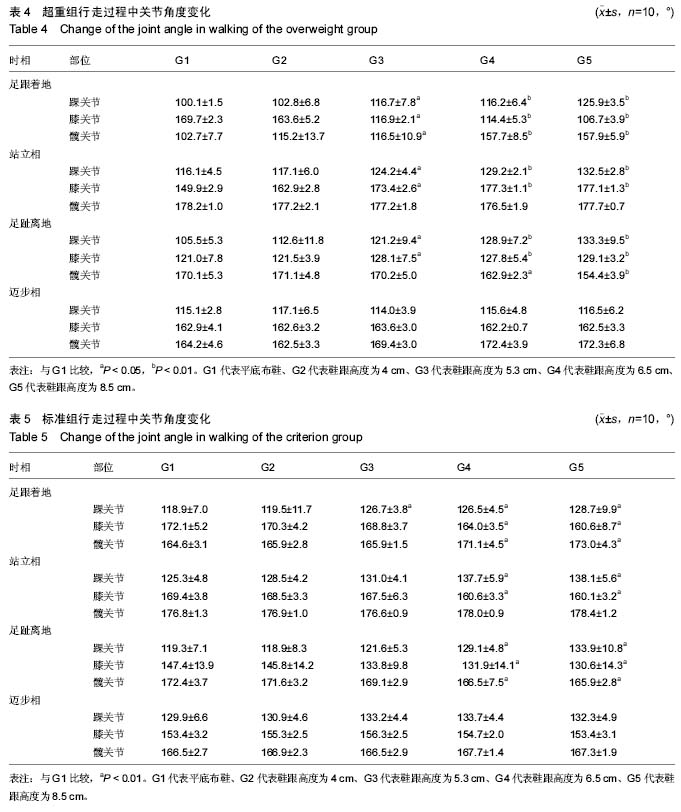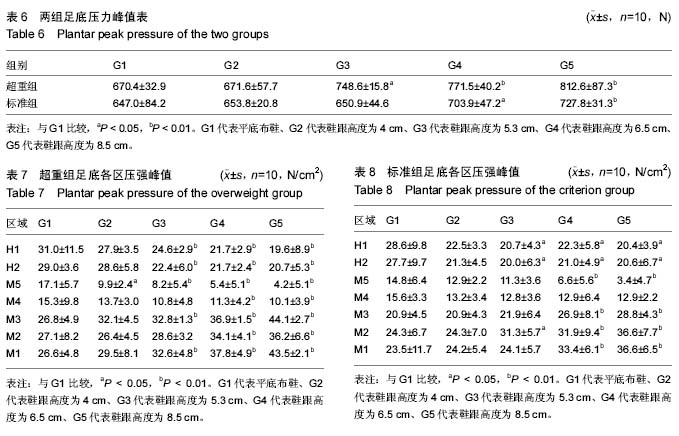中国组织工程研究 ›› 2016, Vol. 20 ›› Issue (49): 7349-.doi: 10.3969/j.issn.2095-4344.2016.49.008
• 运动医学动物模型 Animal models of sports medicine • 上一篇 下一篇
不同体质量指数成年女性穿高跟鞋行走步态特征分析
闫红光
- 沈阳体育学院运动人体科学学院,辽宁省沈阳市 110101
Walking gait characteristics of adult women with different body mass indexes wearing different height heels
Yan Hong-guang
- Sport Science School of Shenyang Sport University, Shenyang 110101, Liaoning Province, China
摘要:
文章快速阅读:
.jpg) 文题释义:
体质量指数:是指体质量与身高平方的比值,简称BMI。是世界公认的一种评定肥胖程度的分级方法,世界卫生组织(WHO)也以体质量指数来对肥胖或超重进行定义。由于肥胖会导致人类在行走时下肢承重增加,当体质量指数超越一定限度时,人们的行走姿态会发生相应的改变。
步态分析:为了确切对步态特征及行走能力进行描述,通常选取相关指标,如支撑相、摆动相及二者的比值等。在常速行走时,当一侧下肢进入支撑时相时,另侧下肢尚未离地,两下肢同时负重称为双肢负重期,时间占一个步态周期的28.8%,支撑时相的其他时间为单肢负重期。随年龄的增长,单、双支撑时相占步态周期的比例随之增加。双肢负重相的长短与行走的速度密切相关,速度越快,双肢负重相占的时间越短,奔跑则不存在双肢负重相。在双肢负重相结束,从一侧下肢单独负重到再一次进入双肢负重之间的一段时间,称为单肢负重期。对某一单足而言,站立相和摆动相约各占周期的61%和39%。偏瘫患者双下肢显示出不同的站立相及摆动相时间,患病肢体的站立相时间缩短,摆动相的时间延长,说明患病肢体负重能力减弱。
文题释义:
体质量指数:是指体质量与身高平方的比值,简称BMI。是世界公认的一种评定肥胖程度的分级方法,世界卫生组织(WHO)也以体质量指数来对肥胖或超重进行定义。由于肥胖会导致人类在行走时下肢承重增加,当体质量指数超越一定限度时,人们的行走姿态会发生相应的改变。
步态分析:为了确切对步态特征及行走能力进行描述,通常选取相关指标,如支撑相、摆动相及二者的比值等。在常速行走时,当一侧下肢进入支撑时相时,另侧下肢尚未离地,两下肢同时负重称为双肢负重期,时间占一个步态周期的28.8%,支撑时相的其他时间为单肢负重期。随年龄的增长,单、双支撑时相占步态周期的比例随之增加。双肢负重相的长短与行走的速度密切相关,速度越快,双肢负重相占的时间越短,奔跑则不存在双肢负重相。在双肢负重相结束,从一侧下肢单独负重到再一次进入双肢负重之间的一段时间,称为单肢负重期。对某一单足而言,站立相和摆动相约各占周期的61%和39%。偏瘫患者双下肢显示出不同的站立相及摆动相时间,患病肢体的站立相时间缩短,摆动相的时间延长,说明患病肢体负重能力减弱。
.jpg) 文题释义:
体质量指数:是指体质量与身高平方的比值,简称BMI。是世界公认的一种评定肥胖程度的分级方法,世界卫生组织(WHO)也以体质量指数来对肥胖或超重进行定义。由于肥胖会导致人类在行走时下肢承重增加,当体质量指数超越一定限度时,人们的行走姿态会发生相应的改变。
步态分析:为了确切对步态特征及行走能力进行描述,通常选取相关指标,如支撑相、摆动相及二者的比值等。在常速行走时,当一侧下肢进入支撑时相时,另侧下肢尚未离地,两下肢同时负重称为双肢负重期,时间占一个步态周期的28.8%,支撑时相的其他时间为单肢负重期。随年龄的增长,单、双支撑时相占步态周期的比例随之增加。双肢负重相的长短与行走的速度密切相关,速度越快,双肢负重相占的时间越短,奔跑则不存在双肢负重相。在双肢负重相结束,从一侧下肢单独负重到再一次进入双肢负重之间的一段时间,称为单肢负重期。对某一单足而言,站立相和摆动相约各占周期的61%和39%。偏瘫患者双下肢显示出不同的站立相及摆动相时间,患病肢体的站立相时间缩短,摆动相的时间延长,说明患病肢体负重能力减弱。
文题释义:
体质量指数:是指体质量与身高平方的比值,简称BMI。是世界公认的一种评定肥胖程度的分级方法,世界卫生组织(WHO)也以体质量指数来对肥胖或超重进行定义。由于肥胖会导致人类在行走时下肢承重增加,当体质量指数超越一定限度时,人们的行走姿态会发生相应的改变。
步态分析:为了确切对步态特征及行走能力进行描述,通常选取相关指标,如支撑相、摆动相及二者的比值等。在常速行走时,当一侧下肢进入支撑时相时,另侧下肢尚未离地,两下肢同时负重称为双肢负重期,时间占一个步态周期的28.8%,支撑时相的其他时间为单肢负重期。随年龄的增长,单、双支撑时相占步态周期的比例随之增加。双肢负重相的长短与行走的速度密切相关,速度越快,双肢负重相占的时间越短,奔跑则不存在双肢负重相。在双肢负重相结束,从一侧下肢单独负重到再一次进入双肢负重之间的一段时间,称为单肢负重期。对某一单足而言,站立相和摆动相约各占周期的61%和39%。偏瘫患者双下肢显示出不同的站立相及摆动相时间,患病肢体的站立相时间缩短,摆动相的时间延长,说明患病肢体负重能力减弱。摘要
背景:女性穿高跟鞋经常出现不适现象,且对身体有潜在的致病作用,因此有必要探讨不同鞋跟高度对人体行走步态影响及损伤的生物力学机制。
目的:研究不同身体质量指数成年女性穿不同高度高跟鞋行走时的步态特征。
方法:依据身体质量指数将20位成年女性分为超重组与标准组,采用三维录像解析系统和足底压力测试系统,对穿平底鞋和不同高度高跟鞋行走时的步态特征进行同步测试,并采集相关的运动学及动力学参数。
结果与结论:①24 kg/m2≤身体质量指数<28 kg/m2人群(超重组)鞋跟高度在5.3 cm以下时比较符合行走时的正常步态特征;18.5 kg/m2≤身体质量指数<24 kg/m2人群(标准组)鞋跟高度在6.5 cm以下时符合行走时的正常步态特征;同时两组人群鞋跟高度在8.5 cm时的步态特征均出现严重异常;②随着鞋跟的增高,两组人群的第一跖骨处、第二跖骨处、第三跖骨处压强峰值均逐渐增加,而第五跖骨与鞋跟高度成反比。
中国组织工程研究杂志出版内容重点:肾移植;肝移植;移植;心脏移植;组织移植;皮肤移植;皮瓣移植;血管移植;器官移植;组织工程
ORCID: 0000-0002-4694-909X(闫红光)
中图分类号:



.jpg) 文题释义:
体质量指数:是指体质量与身高平方的比值,简称BMI。是世界公认的一种评定肥胖程度的分级方法,世界卫生组织(WHO)也以体质量指数来对肥胖或超重进行定义。由于肥胖会导致人类在行走时下肢承重增加,当体质量指数超越一定限度时,人们的行走姿态会发生相应的改变。
步态分析:为了确切对步态特征及行走能力进行描述,通常选取相关指标,如支撑相、摆动相及二者的比值等。在常速行走时,当一侧下肢进入支撑时相时,另侧下肢尚未离地,两下肢同时负重称为双肢负重期,时间占一个步态周期的28.8%,支撑时相的其他时间为单肢负重期。随年龄的增长,单、双支撑时相占步态周期的比例随之增加。双肢负重相的长短与行走的速度密切相关,速度越快,双肢负重相占的时间越短,奔跑则不存在双肢负重相。在双肢负重相结束,从一侧下肢单独负重到再一次进入双肢负重之间的一段时间,称为单肢负重期。对某一单足而言,站立相和摆动相约各占周期的61%和39%。偏瘫患者双下肢显示出不同的站立相及摆动相时间,患病肢体的站立相时间缩短,摆动相的时间延长,说明患病肢体负重能力减弱。
文题释义:
体质量指数:是指体质量与身高平方的比值,简称BMI。是世界公认的一种评定肥胖程度的分级方法,世界卫生组织(WHO)也以体质量指数来对肥胖或超重进行定义。由于肥胖会导致人类在行走时下肢承重增加,当体质量指数超越一定限度时,人们的行走姿态会发生相应的改变。
步态分析:为了确切对步态特征及行走能力进行描述,通常选取相关指标,如支撑相、摆动相及二者的比值等。在常速行走时,当一侧下肢进入支撑时相时,另侧下肢尚未离地,两下肢同时负重称为双肢负重期,时间占一个步态周期的28.8%,支撑时相的其他时间为单肢负重期。随年龄的增长,单、双支撑时相占步态周期的比例随之增加。双肢负重相的长短与行走的速度密切相关,速度越快,双肢负重相占的时间越短,奔跑则不存在双肢负重相。在双肢负重相结束,从一侧下肢单独负重到再一次进入双肢负重之间的一段时间,称为单肢负重期。对某一单足而言,站立相和摆动相约各占周期的61%和39%。偏瘫患者双下肢显示出不同的站立相及摆动相时间,患病肢体的站立相时间缩短,摆动相的时间延长,说明患病肢体负重能力减弱。